The Vatican Museums, which trace their origin to the single sculpture of Laocoön acquired in 1506 by Pope Julius II, were officially founded in the Papal Palace by Pope Clement XIV in 1771 and expanded by Pope Pius VI. Today, the Vatican Museums hold some of the world’s most precious masterpieces, ranging from classical sculptures to Renaissance art. This institution is not just a symbol of the Catholic church’s power and wealth but also serves as one of Rome‘s main cultural attractions and a testament to centuries-long papal patronage of the arts.
Located within the Vatican City, access to the Museums is through Viale Vaticano 6. Encompassing over 70,000 works, of which 20,000 are displayed across multiple galleries, the museum complex includes notable structures, such as the spiral staircase designed by Giuseppe Momo in 1932 and the Sistine Chapel with Michelangelo’s ceiling. The area is immense, with over seven kilometers of galleries and rooms—an architectural marvel connecting various buildings constructed over time under different papacies.
The Vatican Museums house extensive pieces spanning several millennia, from ancient Egyptian artifacts to Etruscan bronzes and from Renaissance oil paintings to modern art. Their assemblage includes works by Raphael, Caravaggio, Leonardo da Vinci, and many other masters from different schools spanning Gothic to Baroque. The collection was primarily formed through Papal commissions, donations given directly to the popes, or acquisitions during their reigns.
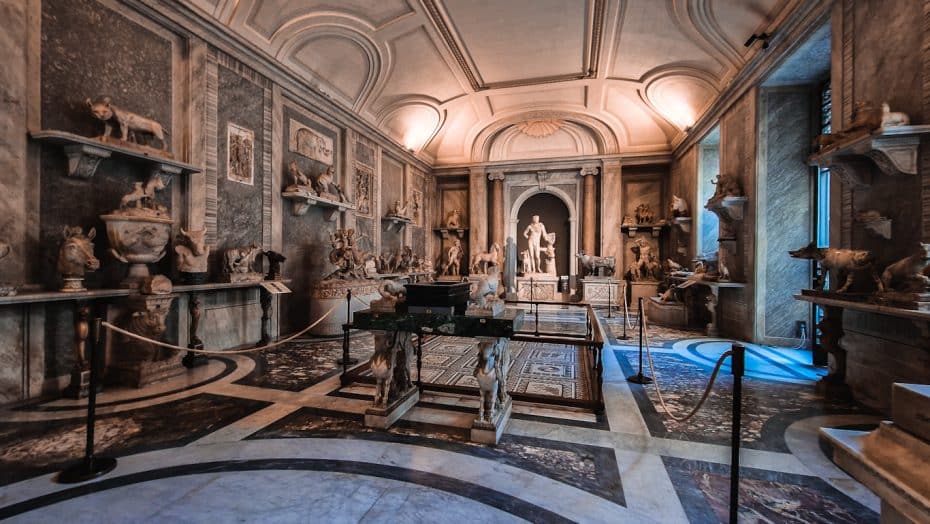
The Vatican Museums are a must-see destination for anyone traveling to Rome. However, its vast collection can be overwhelming. Ideally, visitors should allocate at least a full day to fully immerse themselves in viewing these historic artworks, owing to the sheer size and detail of the museum complex. It can be challenging to fully appreciate the many famous masterpieces in this massive complex of galleries. So, where do we start?
To help you navigate this impressive complex, we’ve compiled a list of the top 21 must-see works of art at the Vatican Museums.
The 21 Artworks You Can’t Miss at the Vatican Museums
1. Laocoön and His Sons
This ancient sculpture was created between 27 BCE and 68 CE, and it is attributed to the artists Agesander, Athenodoros, and Polydorus of Rhodes. Following its discovery in Rome in 1506, it was immediately acquired by Pope Julius II and became one of the first pieces to enter the Vatican Museums’ collection. The sculpture is a significant example of high Hellenistic art, capturing Laocoön, a priest of Troy, with his sons as sea serpents attack them. It is notable for its dramatic agony and masterful depiction of human anatomy.
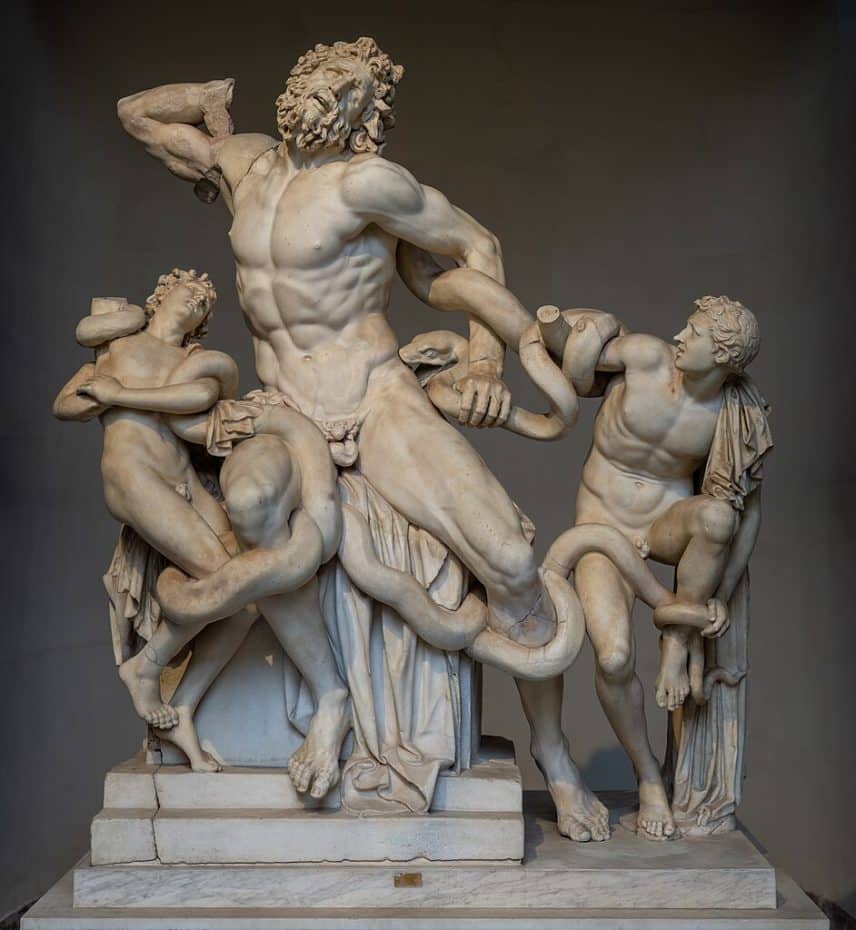
The statue has intrigued artists and scholars for centuries and has been influential in developing Renaissance art. Its excavation was overseen by Giuliano da Sangallo and Michelangelo Buonarroti, who acknowledged its exceptional quality. The missing limbs (particularly the right arm) of Laocoön were reconstructed incorrectly in the past; however, the original position was identified during later discoveries.
“Laocoön and His Sons” is displayed prominently within the Vatican Museums in the Belvedere Courtyard. It lies within the Octagonal Court (Cortile Ottagono), where it continues to captivate visitors with its dynamic expression and composition.
2. The Creation of Adam – Michelangelo’s Sistine Chapel
“The Creation of Adam” is one of Michelangelo’s most iconic frescoes, painted directly onto the ceiling of the Sistine Chapel. It was completed around 1512 during the Renaissance period, under the patronage of Pope Julius II. This masterpiece showcases Michelangelo’s expertise in human anatomy and the use of space, depicting the moment when God breathes life into Adam. The vivid imagery and expressive figures exemplify the High Renaissance artistic style.
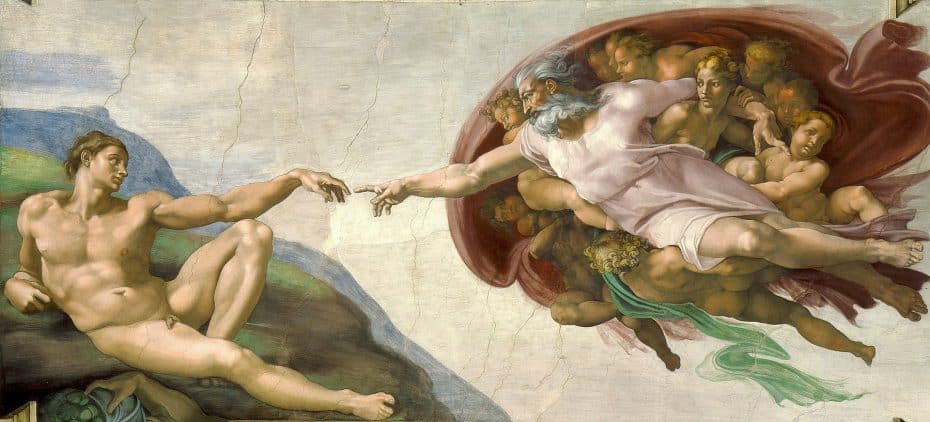
Trivia about “The Creation of Adam” often centers on the hidden symbols within the artwork, such as the shape around God resembling a human brain, which some interpret as a message about divine enlightenment sparking human intellect. Additionally, there is speculation about various anatomical representations within God’s entourage, which may reflect Michelangelo’s extensive knowledge of human anatomy acquired through dissections. Over time, this fresco has become a symbolic representation of human creation and has inspired countless depictions in popular culture.
“The Creation of Adam” rests on the vaulted ceiling of the Sistine Chapel, located in the Apostolic Palace, the official residence of the Pope in Vatican City. Specifically, it is situated on the panel closest to the altar, at nearly the center of the chapel’s ceiling.
3. The School of Athens – Raphael’s Masterpiece
The “School of Athens” is a renowned fresco painted by the Italian Renaissance artist Raffaello Sanzio, more commonly known as Raphael. Created between 1509 and 1511, this exquisite masterpiece forms a part of Raphael’s commission to decorate the rooms now known as the Stanze di Raffaello in the Apostolic Palace in the Vatican. The fresco was commissioned by Pope Julius II, reflecting the pontiff’s ambitious vision of Rome as the world’s intellectual and artistic center. Raphael’s work is a monumental depiction that celebrates the great thinkers of classical antiquity and epitomizes High Renaissance art through its harmonious composition, architectural perspective, and portrayal of ancient philosophers.
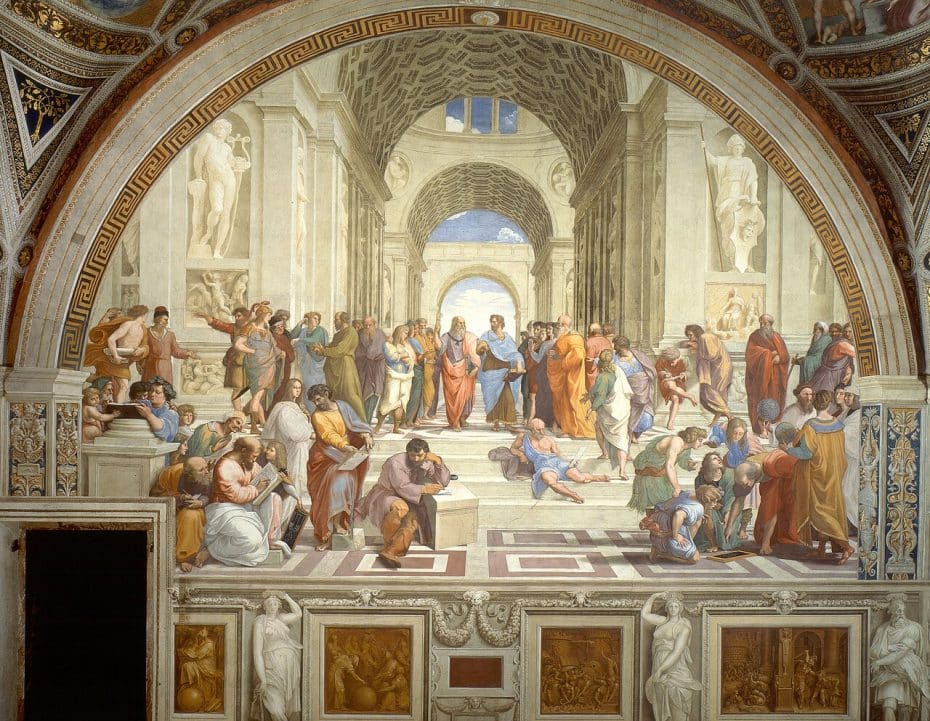
Raphael actually included himself in this vast assembly of great thinkers. He can be seen at the extreme right edge of the painting, gazing directly out at the viewer with quiet confidence—a detail often missed by observers. Also captivating is how Raphael used contemporary figures for some philosophers. For instance, Leonardo da Vinci is depicted as Plato.
“The School of Athens” is located in what is known today as the Raphael Rooms (Stanze di Raffaello), specifically the Stanza della Segnatura—the first room that Raphael and his pupils decorated.
4. The Transfiguration – Raphael’s Last Painting
‘The Transfiguration’ is heralded as one of the greatest Renaissance paintings. Created in 1520, this work was the final piece painted by Raphael before his untimely death the same year at the age of 37. ‘The Transfiguration’ was commissioned by Cardinal Giulio de Medici, who would later become Pope Clement VII, and unveiled to the public shortly after Raphael’s passing. It represents a fusion of High Renaissance and Mannerist styles, capturing Biblical narrative and human emotion. The painting dramatically depicts two scenes from the New Testament: the transfiguration of Christ on a mountain peak and, below it, an episode of an exorcism.
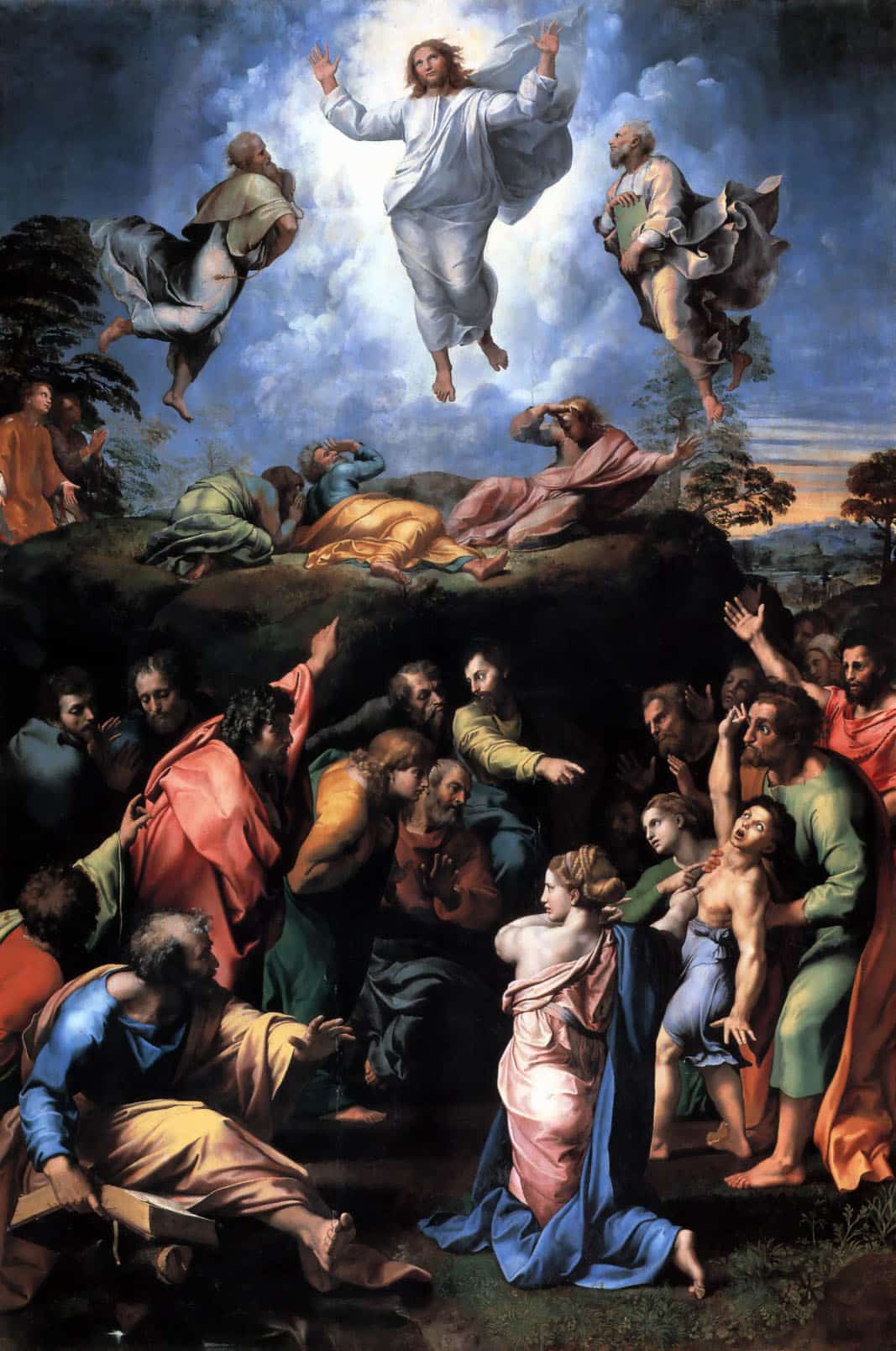
The Transfiguration is particularly notable not only for its vivid depiction but also for its historical significance; it hung above Raphael’s own bier during his funeral in recognition of his contribution to Renaissance art. Additionally, some speculate that Raphael’s sudden death left parts of the painting that his students possibly completed.
Today, The Transfiguration is located in the Pinacoteca Vaticana (Vatican Art Gallery), specifically in Room VIII.
5. The Pietà by Michelangelo in St. Peter’s Basilica
The “Madonna della Pietà,” also known as the “Pietà,” is one of Michelangelo Buonarroti’s renowned sculptures. It represents the Virgin Mary holding the body of Jesus Christ after his crucifixion. Carved from a single block of Carrara marble, this masterpiece was completed in 1499, when Michelangelo was just 24.
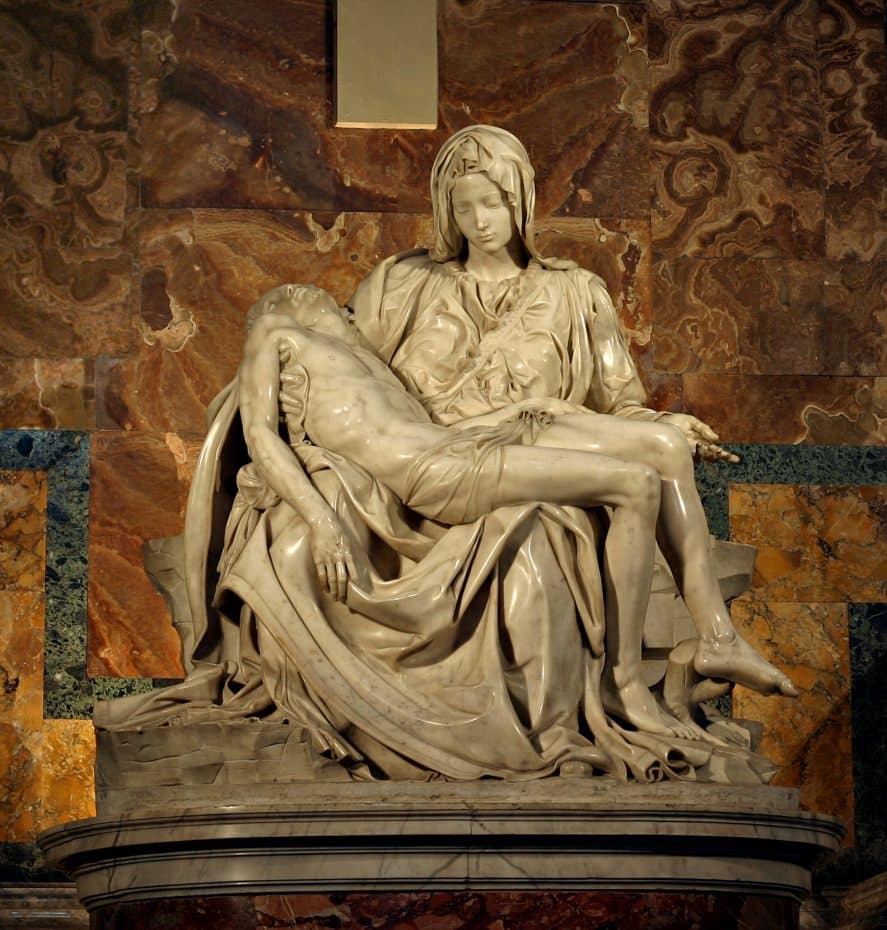
The “Pietà” stands out for its delicate depiction of figures and emotional expression, encapsulating the High Renaissance style. Notably, this is the only work Michelangelo ever signed; his name can be found across Mary’s chest, an act spurred by a story claiming he overheard visitors attribute the work to another sculptor. Another remarkable fact is that despite its delicate appearance, the sculpture has proven its resilience over time, with one significant exception. In 1972, a mentally disturbed geologist attacked the statue with a hammer, breaking Mary’s arm before being subdued. The subsequent restoration was meticulous, requiring reattachment of pieces and careful polishing to restore its original splendor.
Michelangelo’s “Madonna della Pietà” is in St. Peter’s Basilica. It resides specifically in the first chapel to the right upon entering the basilica’s main entrance—the Chapel of the Pietà—and is protected by bulletproof acrylic glass since the aforementioned incident. Visitors can locate it by looking for signs indicating “Cappella della Pietà” while navigating through St. Peter’s Basilica’s majestic interior.
6. Apollo Belvedere
The Apollo Belvedere is a renowned Ancient Greek sculpture rediscovered in the late 15th century and immediately admired for its exemplary representation of classical beauty. The exact year of the original creation remains uncertain, but it is believed to have been sculpted between the 1st and 2nd centuries AD. The sculptor’s identity is similarly elusive, though some attribute it to Leochares, an ancient Greek sculptor from the 4th century BC. The Vatican acquired this masterpiece in the 16th century, owing to Pope Julius II, whose pontificate lasted from 1503 to 1513.
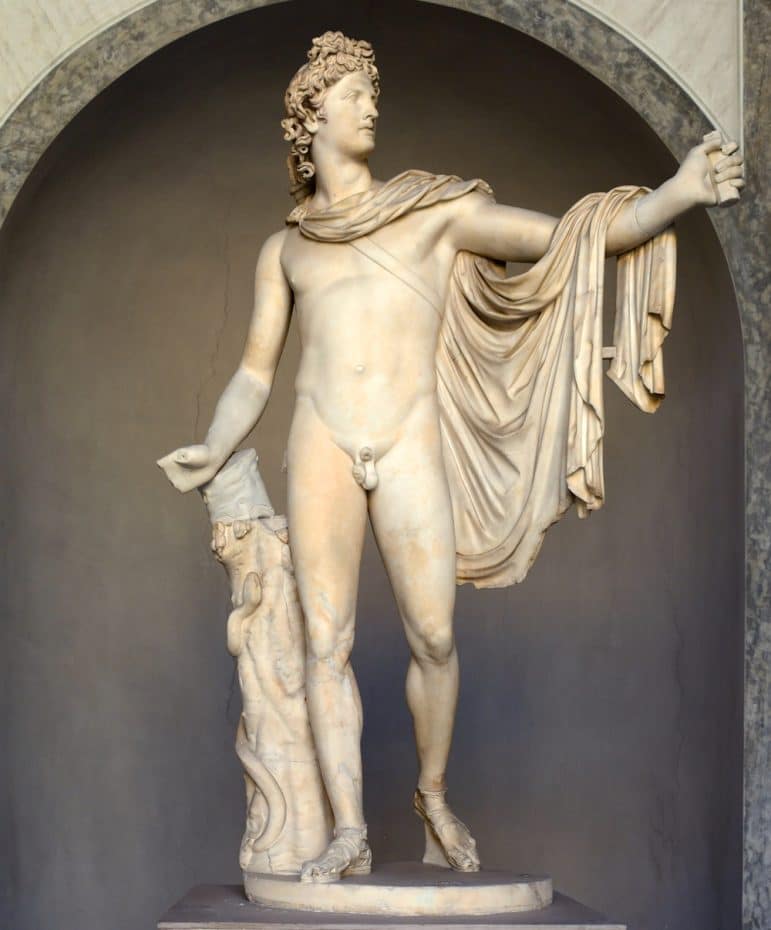
The sculpture embodies the High Classical style of ancient Greece, notable for features such as contrapposto stance and idealized anatomical forms. It depicts Apollo, the Olympian god of music and poetry, in a moment of poised action with his left hand extended, perhaps once holding a missing attribute like a bow or lyre. A curious fact about it is that it was initially mistaken for the god Pluto until corrected by art connoisseur Giovanni Angelo Montorsoli. For centuries, it stood as a symbol of male beauty and perfection, so much so that Goethe once remarked that it “transcends all description.” It also played a crucial role during the Renaissance, influencing artists with its perfect proportions and becoming a must-study for aspiring artists. The belief in its aesthetic supremacy remained largely unchallenged until the beginning of the 20th century, when art historians started to favor more expressive artworks over those embodying classical ideals.
The Apollo Belvedere Sculpture graces the Vatican Museums within the famed Octagonal Courtyard of the Pio-Clementino Museum.
7. Gallery of Maps – Geographic Artistry on the Vatican Walls
The Gallery of Maps showcases geographical cartography in a stunning visual form. These maps were designed by the friar and geographer Ignazio Danti under the commission of Pope Gregory XIII. They were created between 1580 and 1583 to illustrate the regions of Italy and the Church’s possessions at the time. Each map combines science and art, meticulously depicting Italy’s territories and major landmarks. This was during an era when maps were crucial for the administration and military campaigns. The richly detailed frescoes that line the gallery’s 120 meters are artistic achievements valued for their historical significance.
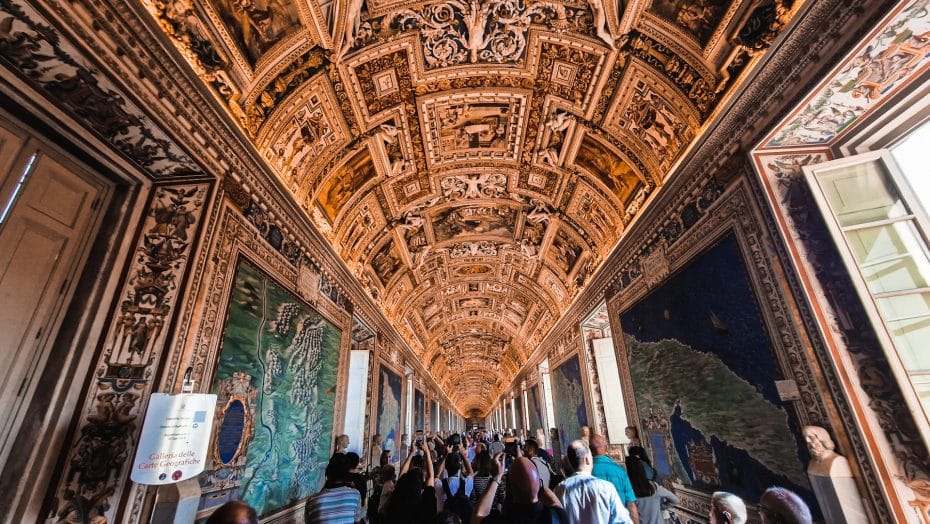
It’s fascinating to note that these maps contain some geographical inaccuracies due to the limited knowledge and technology available at the time. Moreover, one of Danti’s intentions was to reflect physical geography and political dominion. This resulted in a blending of cartography with subtle messages about the power and reach of the papacy during that period. Another curious fact is that along with Italy’s landscapes, Danti included several panels showing important events in Christian history, tying together a religious narrative with topographical representation.
Visitors can find this enchanting collection on the upper floor of the Vatican Palaces. It covers almost an entire wall and extends down a corridor 120 meters long —one of the longest galleries in the museum. Specifically, it is located on the west side of the Belvedere Courtyard, a corridor connecting the Apostolic Palace with the Sistine Chapel.
8. St. Jerome in the Wilderness by Leonardo da Vinci
St. Jerome in the Wilderness is an unfinished masterpiece believed to be started around 1480 by the legendary artist Leonardo da Vinci. The painting’s history is somewhat murky, and its exact time of creation is a matter of expert speculation.
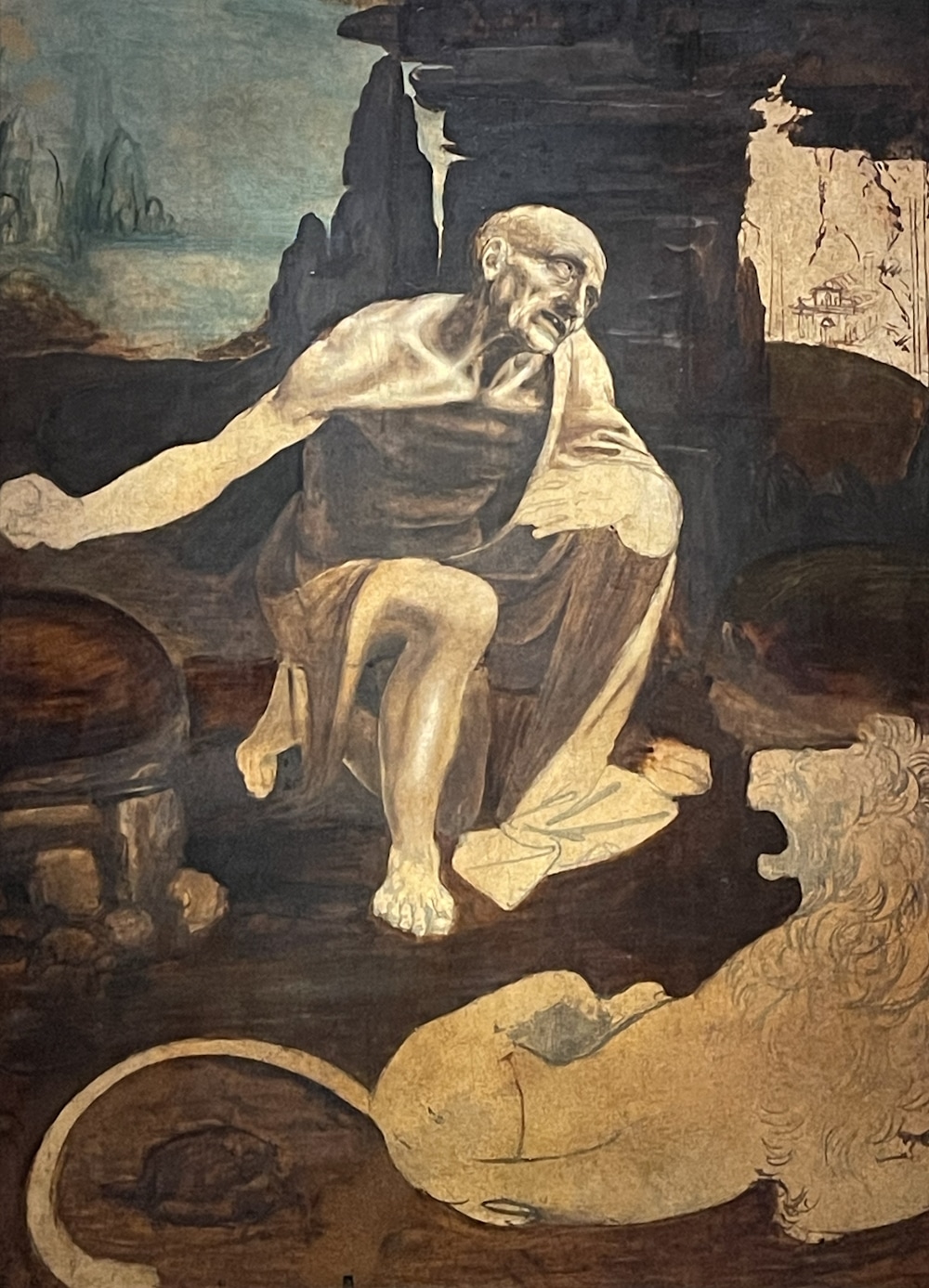
The work was acquired by Pope Pius IX in 1856, making it one of the most prestigious pieces within the Vatican collection. Stylistically, it features da Vinci’s characteristic sfumato technique and conveys a sense of isolation. St. Jerome is depicted as an ascetic figure in a rocky landscape, striking his chest with a stone in penance while a lion rests peacefully in the scene—a reference to legends about St. Jerome taming a lion by removing a thorn from its paw.
St. Jerome in the Wilderness is unique in providing insight into Leonardo’s creative process; its unfinished state allows observers to see his underdrawing and how he built up a composition. It was once cut into pieces before being recognized as da Vinci’s work and later restored. Today, visitors to the Vatican Museums can find this precious artwork in Room XV of the Pinacoteca Vaticana (Vatican Picture Gallery).
9. Madonna of Foligno by Raphael
The Madonna of Foligno is a magnificent piece by the Italian master artist Raphael. Completed in 1511, this work was commissioned by Sigismondo de’ Conti to thank the Virgin Mary for granting him divine assistance following a near-death experience. Pope Julius II acquired the painting, which was later displayed in 1565. It was then gifted to Pope Pius VII, who hung it in the Vatican Museums in 1815. The Madonna of Foligno showcases Raphael’s mastery of the High Renaissance style, blending a splendid array of colors with intimate figures demonstrating depth and emotion.
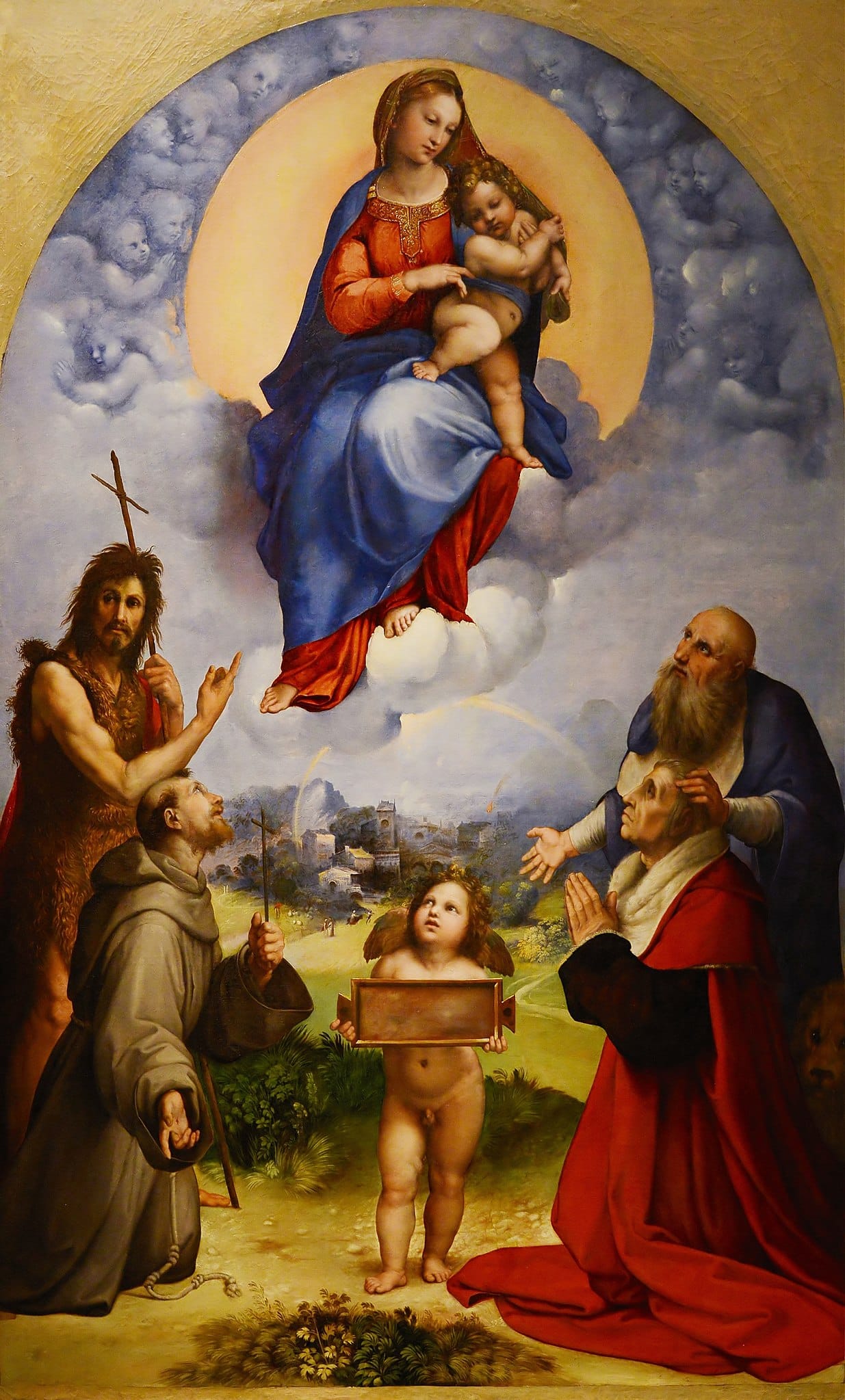
This masterpiece was almost destroyed when the church where it was originally located suffered extensive damage during an earthquake. Luckily, the painting had been moved prior to the event, preventing its destruction. The Madonna of Foligno portrays four saints around the Virgin and Child – Saint John the Baptist, Saint Francis of Assisi, Saint Jerome, and Sigismondo de’ Conti’s patron saint, Saint Nicholas of Tolentino; all surrounded by a celestial vision. The magnificent artwork is housed in Room IX of the Pinacoteca Vaticana (Vatican Art Gallery) within the Vatican Museums.
10. St. Peter Enthroned
The St. Peter Enthroned is a renowned sculpture in the vast Vatican Museum collections. Estimated to have been crafted during the 13th century, this iconic piece is attributed to Arnolfo di Cambio, an Italian architect and sculptor. The Vatican acquired it under Pope Boniface VIII. The sculpture is revered for its embodiment of Gothic art, characterized by its naturalistic style and detail. The image presents St. Peter sitting solemnly, symbolizing ecclesiastical authority and tradition, holding the keys to heaven.
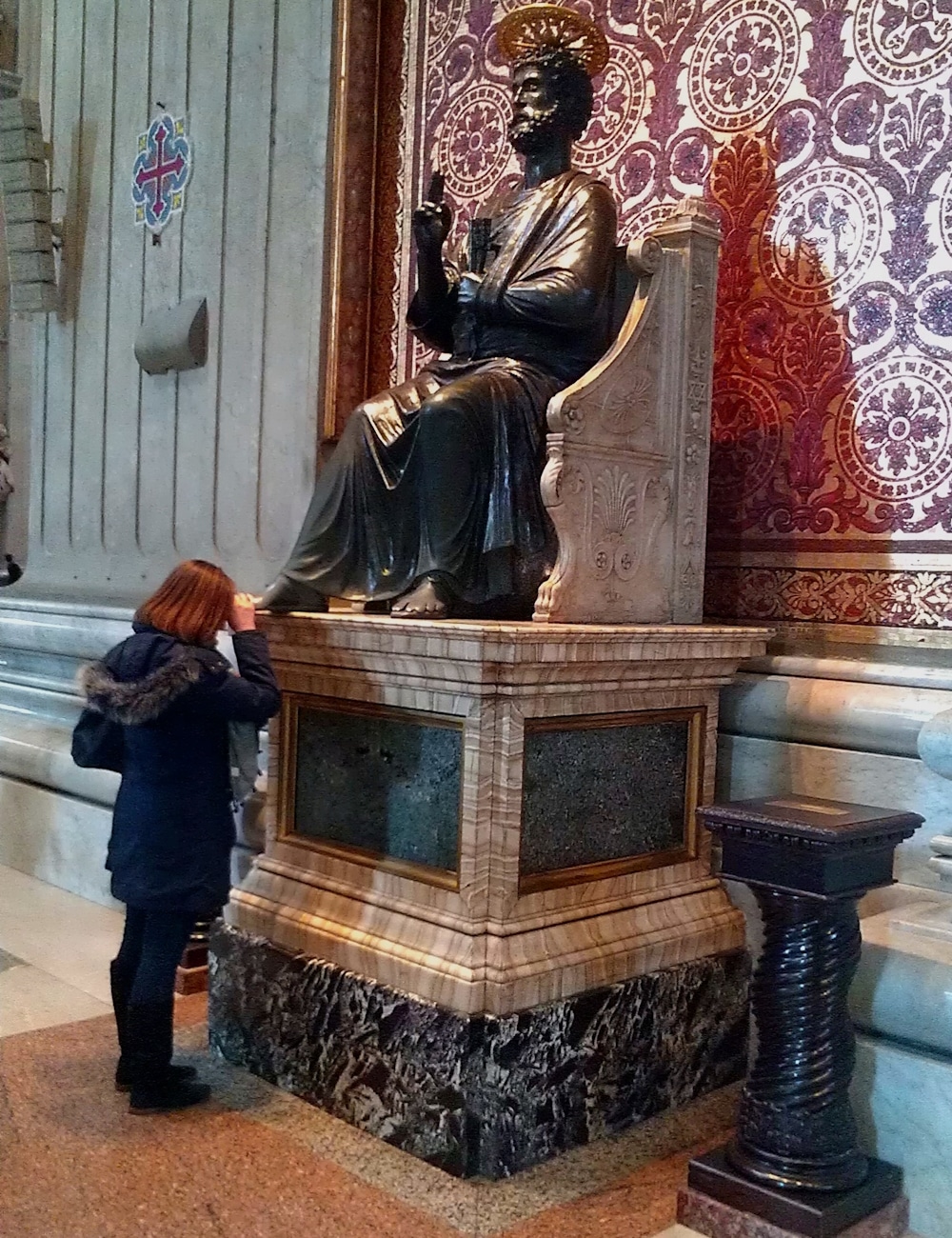
It is believed that faithful visitors who touch or kiss the foot of St. Peter’s statue will receive heavenly favors, which has resulted in the right foot being worn down considerably over time. Another curious fact is that during papal coronations, the statue was dressed with an actual papal tiara, ring, and vestments representing St. Peter’s symbolic presence at these significant events.
11. Belvedere Torso – A Hellenistic Marble Masterpiece
The Belvedere Torso is an ancient marble sculpture renowned for its exquisite craftsmanship and influence. Carved during the 1st century BC, the masterpiece is attributed to the Athenian sculptor Apollonius, son of Nestor, as indicated by the signature on the sculpture itself. Acquired for the Vatican’s collection by Pope Julius II in the early 16th century, it has since remained one of the Vatican Museums’ most famous pieces. The sculpture is an exemplary piece of Hellenistic art, characterized by its realistic musculature and dramatic twist of the torso that captures a sense of movement and tension within the stone. Though it lacks limbs and a head, this fragment of a larger statue depicts the torso of a male figure—possibly Heracles—demonstrating extraordinary sculptural skills in rendering human anatomy.
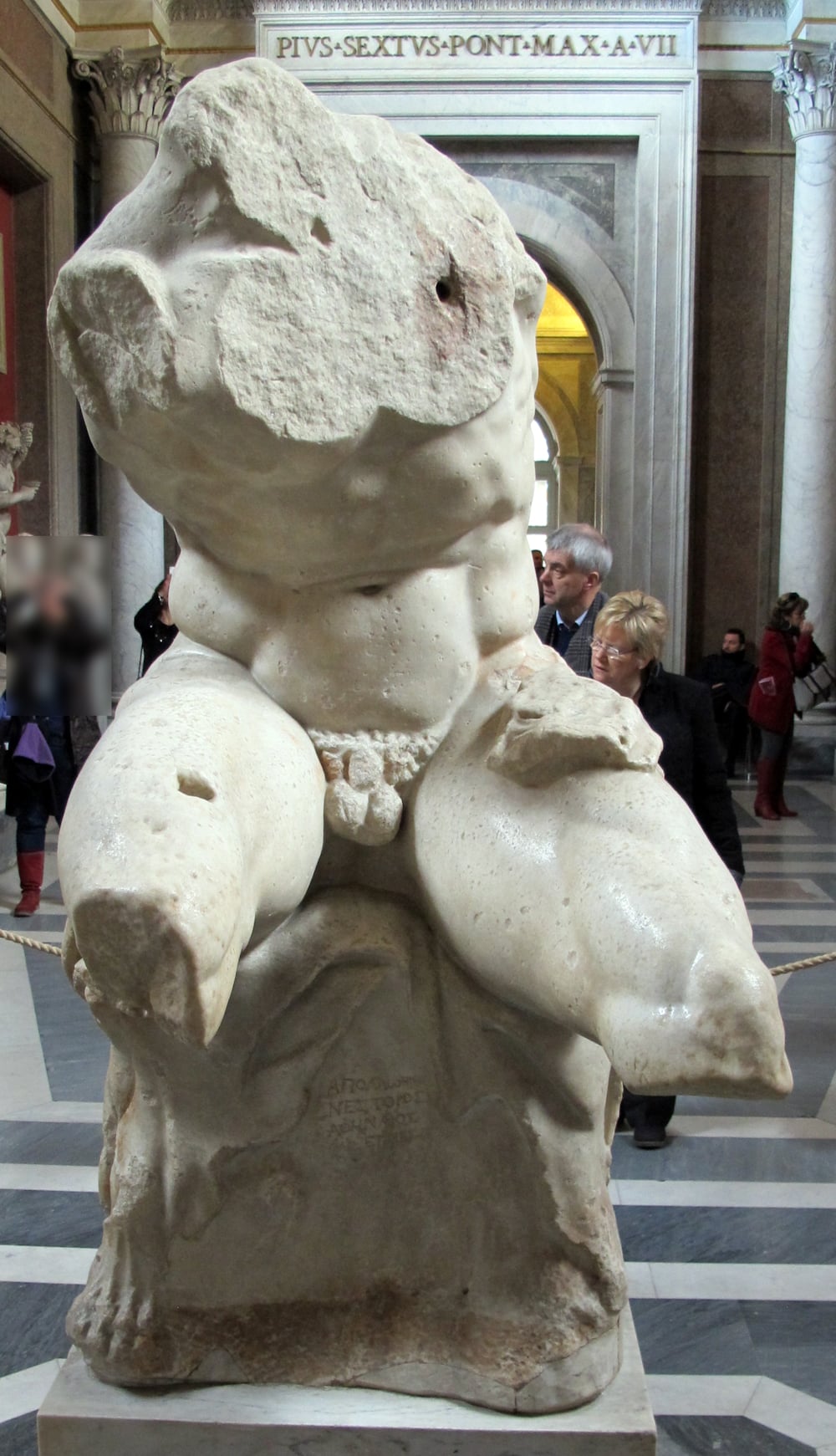
The Belvedere Torso has profoundly influenced art and artists for centuries; perhaps most notably, Michelangelo Buonarroti revered it for its perfection, drawing inspiration from it for his work on the Sistine Chapel. He allegedly claimed that this torso was sufficient to represent all art and that seeing more was unnecessary. Despite numerous requests and pressures to restore it by adding limbs and a head, Michelangelo argued against such modifications, so the piece remains incomplete as originally found. Today, visitors can find this remarkable sculpture in the Museo Pio-Clementino within the Vatican Museums, in the Sala delle Muse, room VIII, surrounded by other classical sculptures in a space designed by Bramante.
12. The Adoration of the Magi by Leonardo da Vinci
The Adoration of the Magi by Leonardo da Vinci is an unfinished work that offers a glimpse into the masterful techniques of one of Renaissance Italy’s most revered artists. Though never completed, the painting began in 1481. It is heralded for its composition and innovative use of perspective characteristic of da Vinci’s style. The piece showcases an array of figures arranged in a complex and dynamic scene surrounding the central figures of the Virgin Mary and Child Jesus.
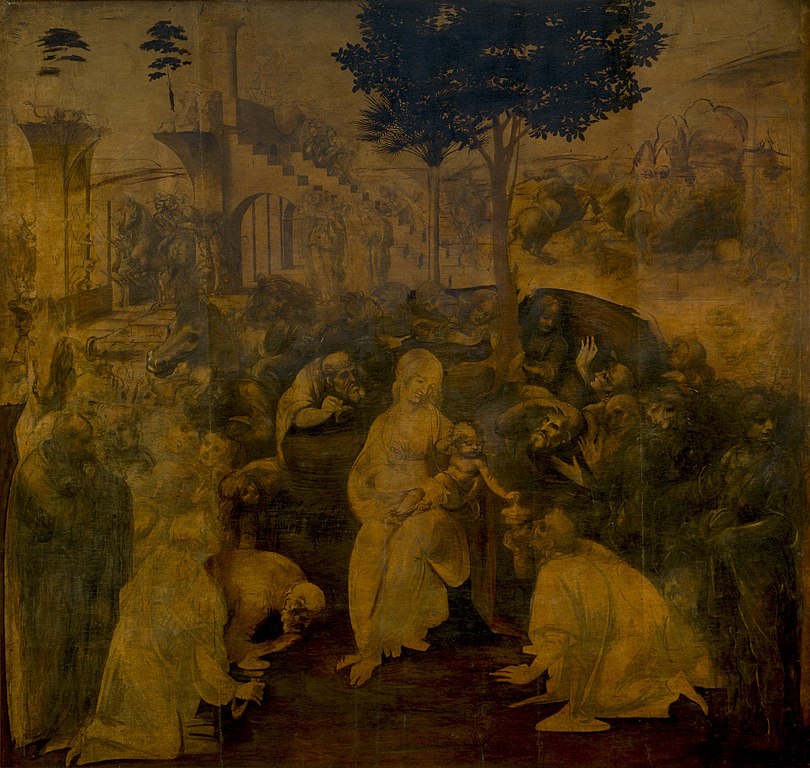
Leonardo left the piece unfinished because he moved to Milan in 1482 to serve Duke Ludovico Sforza. The abandoned masterpiece reveals much about Leonardo’s creative process through its detailed underdrawings visible beneath scant layers of paint. This unique state allows scholars to study his evolving ideas and techniques directly. Additionally, it’s speculated that some faces in the crowd may be early examples of da Vinci’s experiments with caricature. The Adoration of the Magi is situated in the Pinacoteca Vaticana (Vatican Art Gallery).
13. The Last Judgement – Michelangelo’s Sistine Chapel Sequel
Michelangelo’s “The Last Judgment” is a monumental fresco that adorns the altar wall of the Sistine Chapel. Commissioned by Pope Clement VII, the work was begun under his papacy around 1536. Following Clement VII’s death, the project continued under Pope Paul III Farnese, who was particularly keen on its completion. Michelangelo completed this masterpiece in 1541 after several years of solitary labor. Giotto di Bondone’s influence on Michelangelo is evident in his emphasis on human emotion and the physicality of the figures. However, Michelangelo transcends Giotto’s style through his use of complex composition and his own unique approach to conveying psychological intensity.
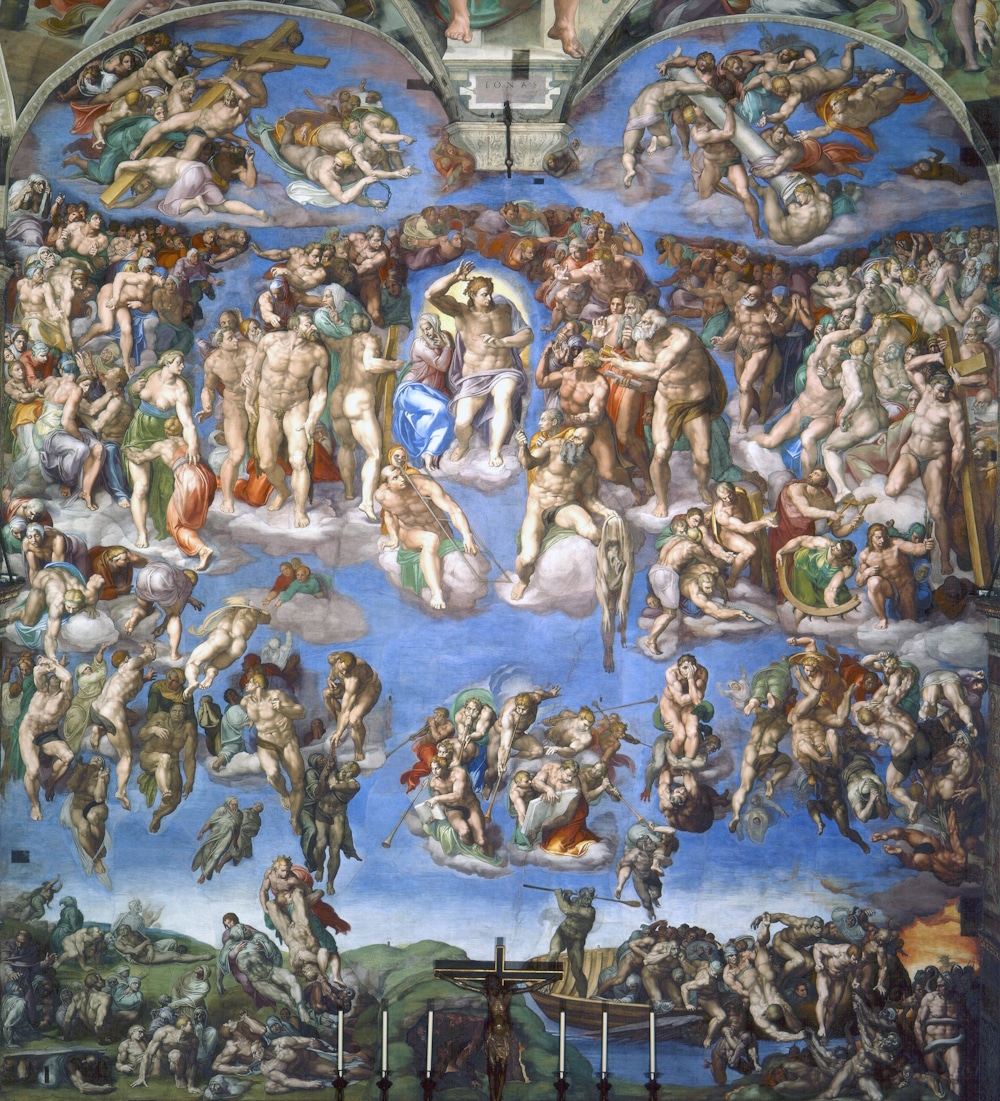
“The Last Judgment” represents a departure from the serenity of Michelangelo’s earlier Sistine Chapel ceiling to a dynamic and dramatic scene reflecting the changing religious and artistic landscape of the mid-16th century. The fresco depicts the second coming of Christ and the final judgment of souls, with the blessed ascending to heaven on Christ’s right and the damned descending to hell on his left. The style is Mannerist, characterized by elongated figures and exaggerated musculature, which contributes to a sense of movement and drama. It is also noted for its vivid color palette.
Biagio da Cesena, the Vatican’s Master of Ceremonies during Michelangelo’s time, criticized the nudity present in the fresco, calling it more suitable for public baths or taverns than a sacred chapel. In response to these complaints and post-Tridentine decorum standards, Pope Pius IV initiated a campaign led by artist Daniele da Volterra, who added draperies to cover some of the figures’ genitals. Years later, from 1980 to 1994, “The Last Judgment” underwent a major cleaning and restoration that revived its original color, brightness, and detail.
Michelangelo’s “The Last Judgment” is in the Sistine Chapel of the Apostolic Palace.
14. Bacchus and Ariadne by Guido Reni
Bacchus and Ariadne is a famous Baroque painting by Guido Reni. It depicts the encounter between Bacchus, the god of wine, and Ariadne, daughter of King Minos of Crete, with a style noted for its dynamic composition and use of light to model the forms.
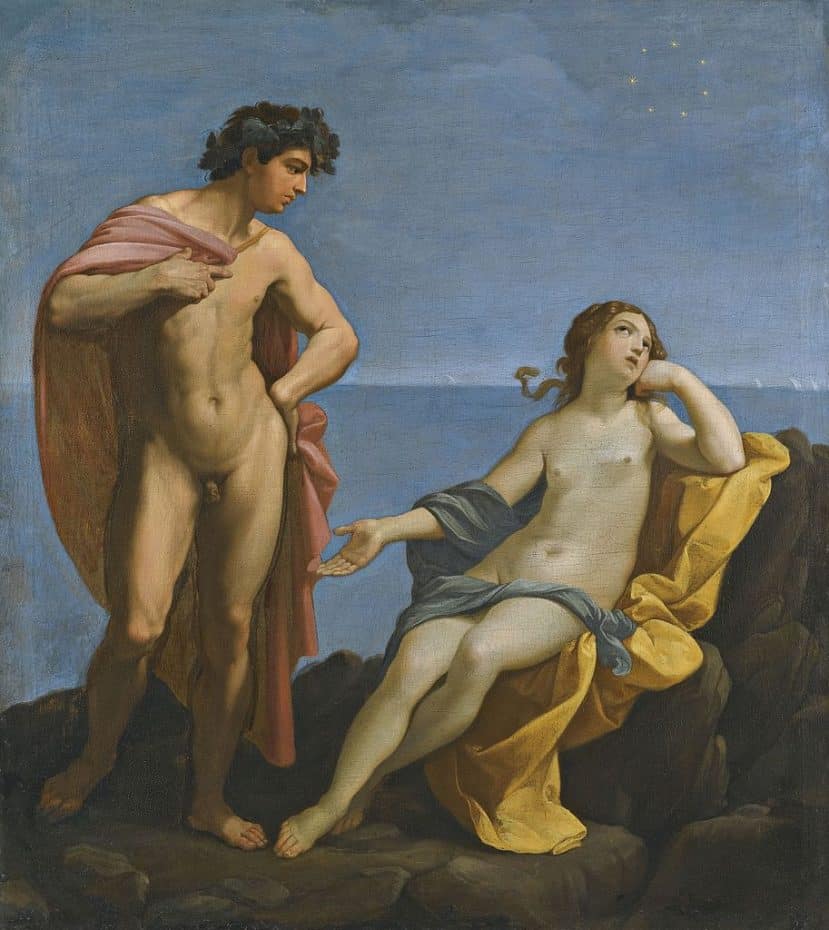
One interesting fact is that Guido Reni produced this work during his mature period when he shifted toward using cooler colors and developed an ethereal lightness in his depiction of figures. This tendency is evident in Bacchus and Ariadne. Fascinatingly, Reni’s representation of mythological subjects, such as in this piece, often reflected the tension between worldly passion and spiritual purity—a theme that resonated deeply during the Counter-Reformation. Today, ‘Bacchus and Ariadne’ is on display in Room VIII in the Pinacoteca Vaticana (Vatican Picture Gallery).
15. Pinturicchio’s Frescoes in the Borgia Apartments
The Borgia Apartments in the Vatican Museums are home to a collection of frescoes by Bernardino di Betto, known as Pinturicchio, an eminent painter during the Italian Renaissance. The frescoes were painted around 1492-1494, during the papacy of Pope Alexander VI, Rodrigo Borgia, after whom the rooms and the apartments are named. Pinturicchio’s work represents one of the most remarkable examples of the transition from medieval to Renaissance art styles.
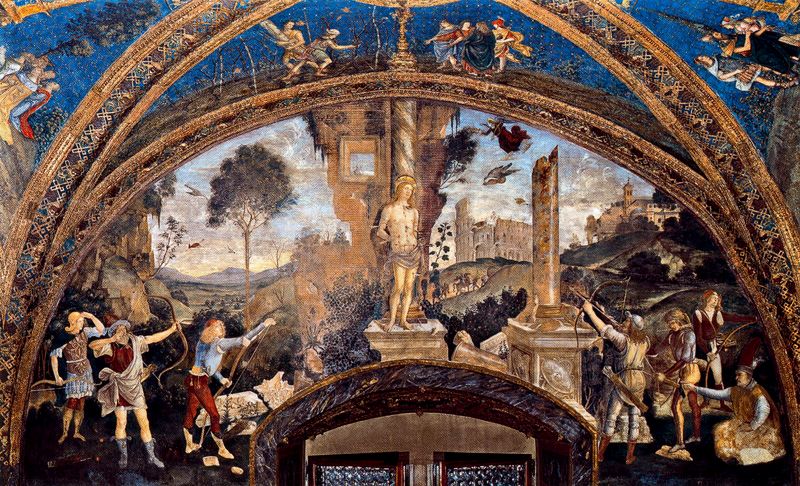
Curiously, the frescoes remained hidden under layers of paint for several centuries until their rediscovery in the late 19th century during restoration. It’s said that these frescoes contain one of the earliest known depictions of Native Americans, influenced by Christopher Columbus’s return from the New World, which coincided with their creation.
Situated on the second floor of the Apostolic Palace, these historically rich frescoes can be found in several rooms, including the Room of the Sibyls and Room of Mysteries.
16. Gregorian Egyptian Museum Collections
The collection within the Gregorian Egyptian Museum constitutes one of the most significant assemblages of ancient Egyptian art and artifacts outside Egypt.
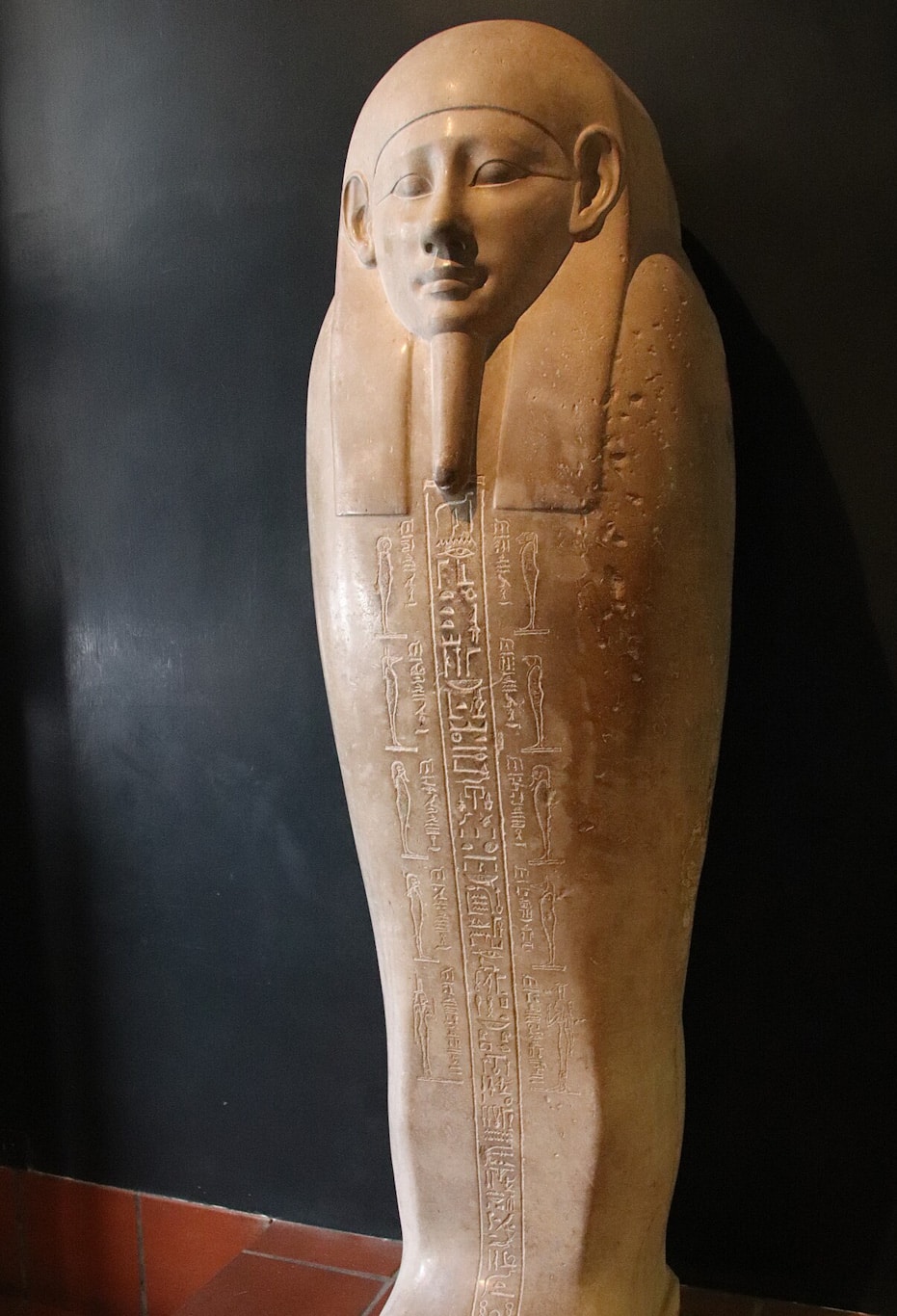
The museum was founded by Pope Gregory XVI in 1839, and it showcases an extensive array of items created during various periods of Egyptian history, from the Age of the Pharaohs to the Roman era. A notable work from this collection is the statue of Anubis, the ancient Egyptian god associated with mummification and the afterlife. The museum’s pieces were acquired over time through various means, including donations, purchases, and archaeological excavations sponsored by successive pontiffs.
17. Martyrdom of St Erasmus
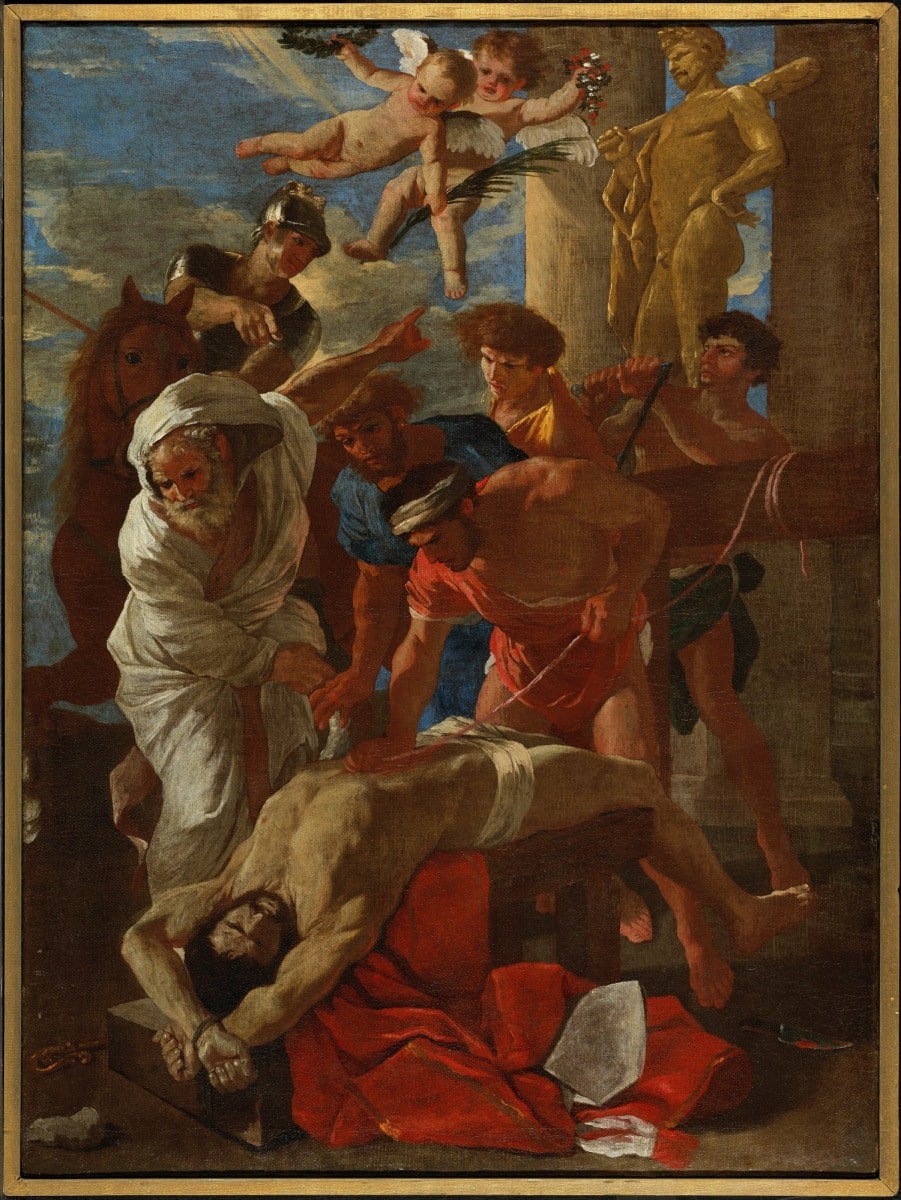
The “Martyrdom of St Erasmus” is an awe-inspiring work of art by Nicolas Poussin, created in 1628. Poussin, a leading painter of the classical French Baroque style, skillfully composed this historical piece that vividly depicts the excruciating tragedy of St Erasmus’s martyrdom. The Vatican acquired the artwork under the patronage of Pope Clement IX in the 17th century.
18. Deliverance of Saint Peter by Raphael
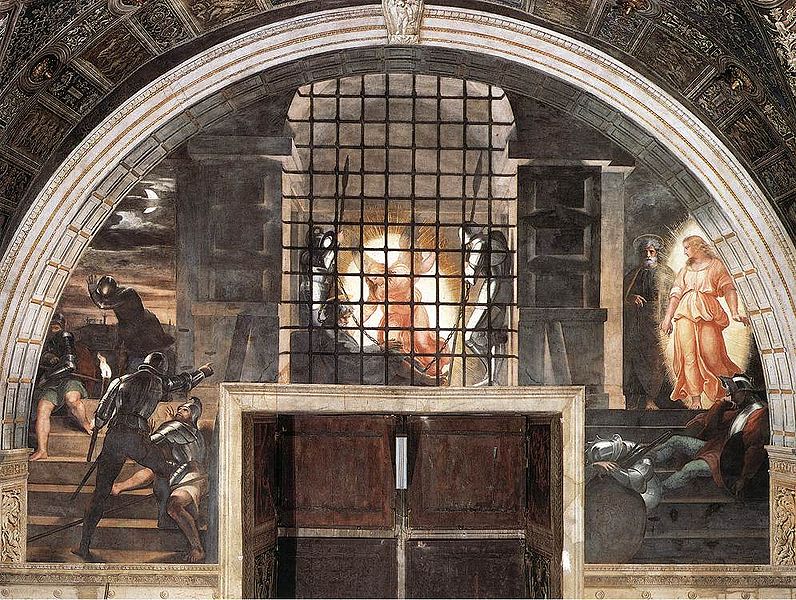
The Deliverance of Saint Peter is a fresco painted by Raphael. This significant piece was created in 1514 as part of Raphael’s commission to decorate the Stanza di Eliodoro. Pope Julius II commissioned it and later completed it under the patronage of his successor, Pope Leo X. The fresco is characterized by its vivid imagery, harmonious composition, and dramatic use of chiaroscuro to depict light and shadow—techniques that Raphael mastered and that illustrate his genius in bringing biblical narratives to life.
19. Augustus Of Prima Porta
The Augustus of Prima Porta is a famous marble statue of the first Roman Emperor, Caesar Augustus. Commissioned in 20 B.C., it is one of the most iconic artworks of the ancient world. The sculpture was unearthed in 1863 at the Villa of Livia near Prima Porta, north of Rome, a residence belonging to Livia Drusilla, who was Augustus’ wife.
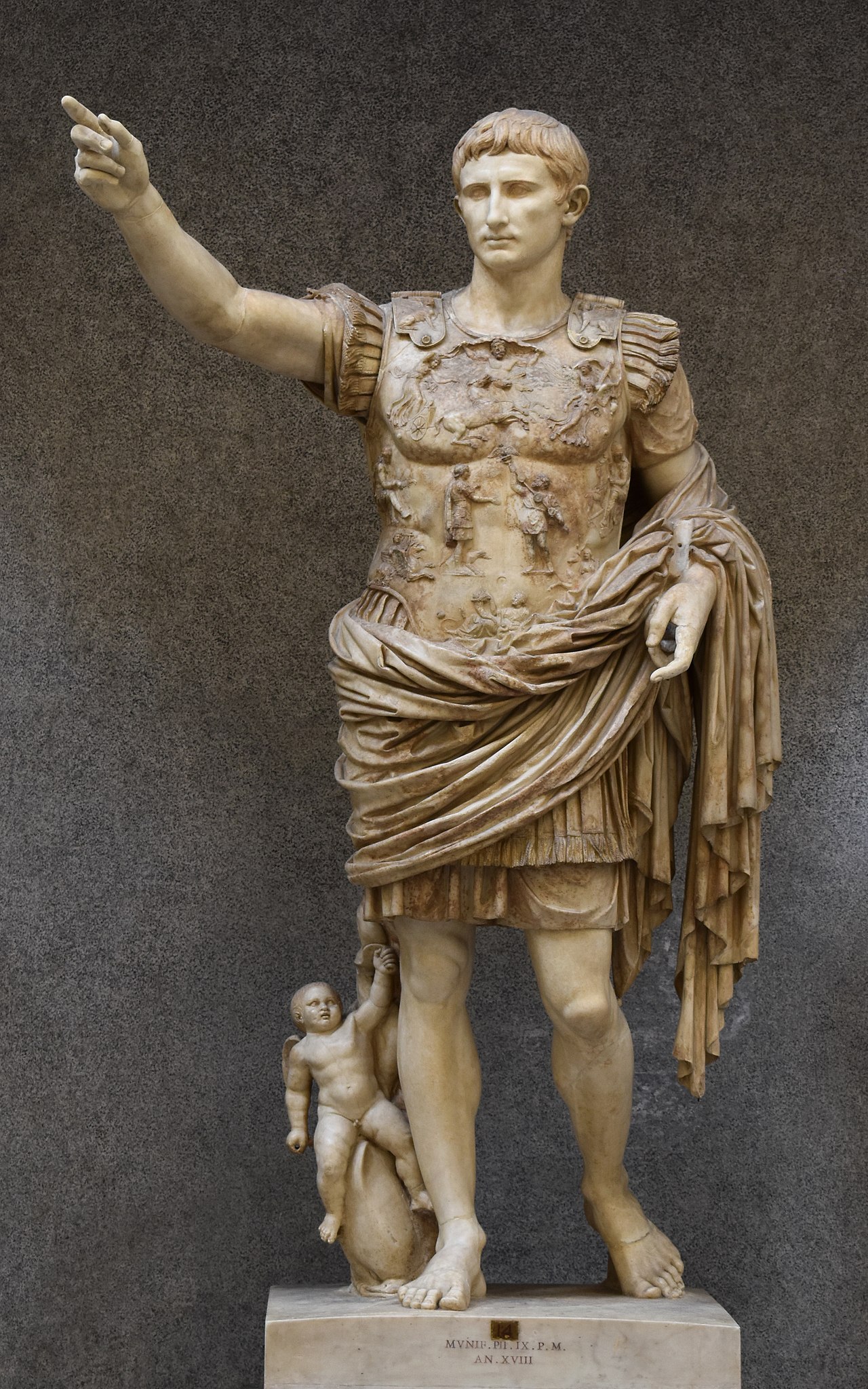
The magnificent piece captures Augustus in a commanding pose, with proportions and styling that reflect the idealism of Classical art. Given its adherence to the Greek canon of proportions and formality, it’s widely thought that it may have been created by or inspired by Polykleitos or his followers.
The statue stands out for several intriguing features, including an intricately detailed breastplate that represents diplomatic feats and the god Mars’ return from war. Another fascinating aspect is Augustus’ barefoot stance; in Roman culture, this depicted divine status or apotheosis upon dying. It also incorporates a small Cupid riding a dolphin on his right leg, symbolizing his claimed descent from the goddess Venus and a naval victory at Actium. It should be noted that though originally painted in vibrant colors, only traces remain to suggest its former polychrome glory.
20. Roman-Era Mosaics
The Roman Mosaics in the Vatican Museums are a stunning testament to ancient Roman artistic skills and have fascinated visitors for centuries. Many pieces were likely amassed during the Renaissance, when there was a renewed interest in classical art and culture. The style of these mosaics ranges from geometric patterns to elaborate mythological scenes, each piece meticulously assembled using small tesserae—colored stones, glass, or ceramic.
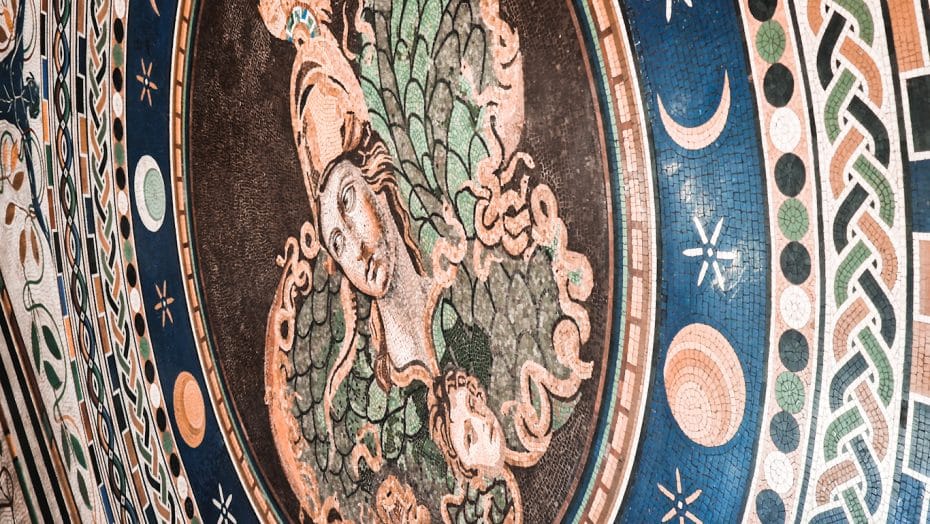
Some of these mosaics were originally floors in luxurious Roman villas and baths. Their complexity and the quality of materials used reflect the wealth and status of the owners. Others provide insights into ancient Roman daily life and beliefs by depicting activities like hunting and imagery related to gods and goddesses.
Today, these mosaics can be found in various locations around the Vatican Museums. Still, many are housed within the Gregorian Profane Museum in room XIV, dedicated exclusively to showcasing classical artifacts like these masterpieces from ancient Rome.
21. The Entombment of Christ
The “Entombment of Christ” is a renowned work by the Italian Renaissance artist Caravaggio, also known as Michelangelo Merisi, and was created in 1603-1604. This masterpiece is one of Caravaggio’s most poignant works, capturing the moment Christ’s body is placed in the tomb. The Vatican acquired the painting during the pontificate of Pope Paul VI in 1970.
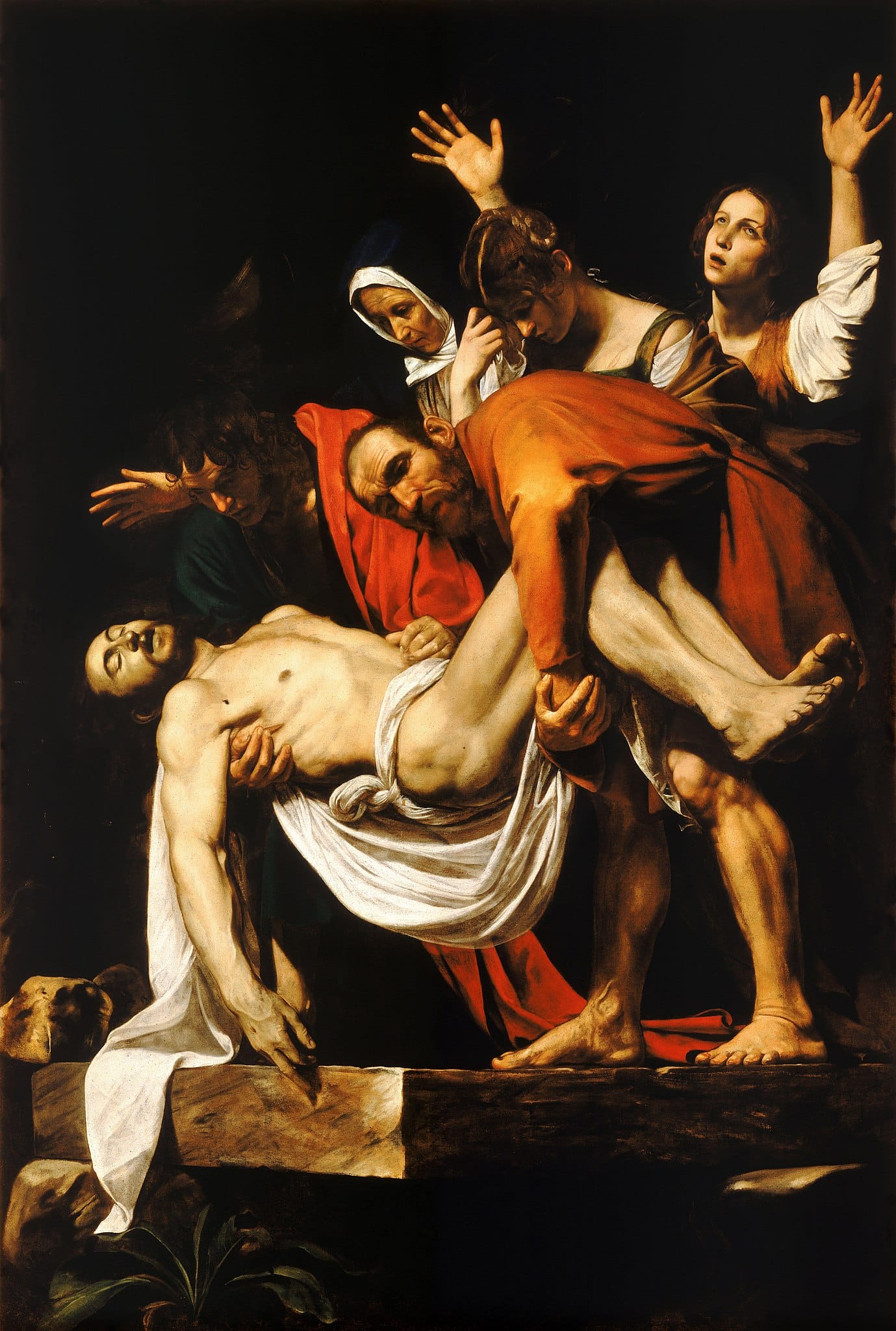
Caravaggio’s unique style, characterized by dramatic lighting and realistic depictions of human emotion, is fully present in this work. The painting stands out for its chiaroscuro technique.
Art historians have noted that Caravaggio used real people from his time as models for his religious figures, giving a more authentic and down-to-earth dimension to his biblical scenes. Unlike other artists who idealized their subjects, Caravaggio’s penchant for naturalism often brought him into conflict with church authorities who were more accustomed to traditional representations of sacred characters. Visitors can find this work on display in Room VIII (Room of the Aldobrandini Madonna), located on the upper floor of the Pinacoteca (art gallery) in the Vatican Museums.
Tips for visiting the Vatican Museums in Rome
- Buy Your Tickets Online in advance to avoid long lines. This will give you a scheduled entry time and faster access to the museums.
- Opt for the Right Timing: The Vatican Museums are less crowded late in the afternoon, especially on weekdays. Consider visiting at this time to explore the museums more comfortably.
- Use the Official Audio Guide: The museums offer an official audio guide that provides detailed information about the artworks and history of the Vatican Museums. This can enhance your visit significantly.
- Dress Appropriately: Since the Vatican is a religious site, appropriate attire is required. This means shoulders and knees should be covered.
- Start from the Top: Begin your tour on the top floor and work your way down. The upper galleries are typically less crowded, so you can enjoy them before reaching the more congested areas.
- Don’t Miss the Sistine Chapel: The Sistine Chapel is a highlight; ensure it’s included in your ticket. Remember that talking and photography are not allowed inside, and there may be long lines to enter.
- Take a Break in the Pinecone Courtyard: It’s a great spot within the museums to relax, have a snack, and admire the beautiful bronze pinecone sculpture.
- Consider a Guided Tour: A guided tour can provide context and insights that you might otherwise miss. Many tours also offer skip-the-line access as an additional perk.
- Plan for Security Checks: Be prepared for airport-style security checks at the museums’ entrances. Bring as few items as possible and avoid prohibited items like large bags or umbrellas to save time.
- Visit Nearby Attractions Afterward: Once you exit the Vatican Museums, you can’t miss visiting St. Peter’s Basilica or nearby Vatican City attractions to make the most of your trip to this unique location.



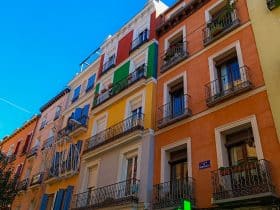
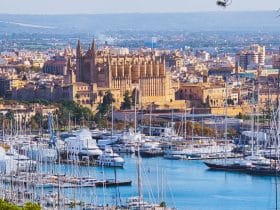
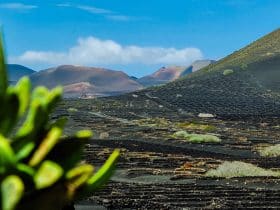
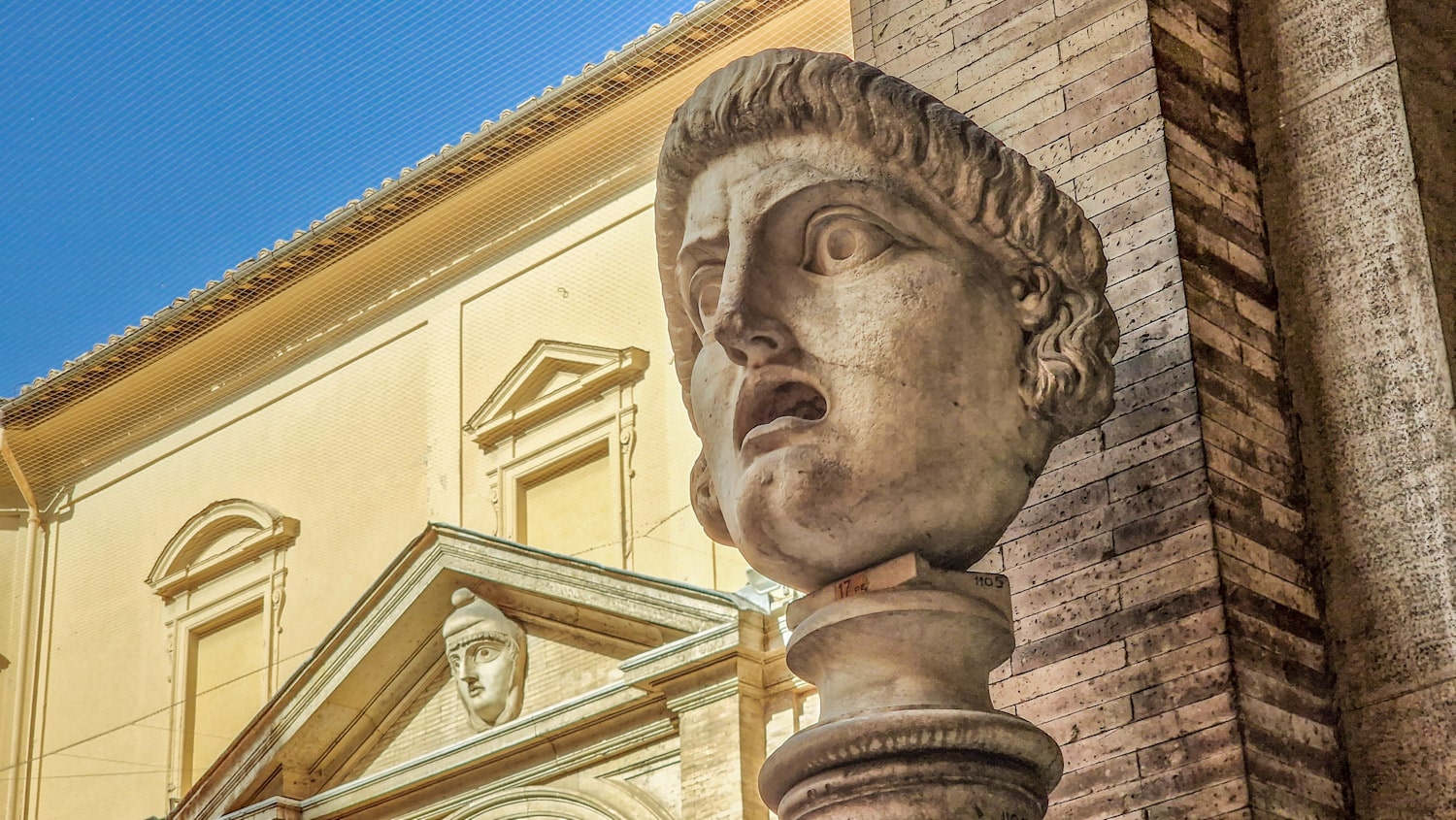
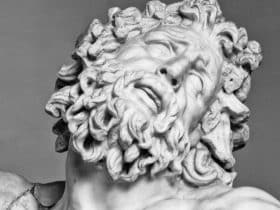
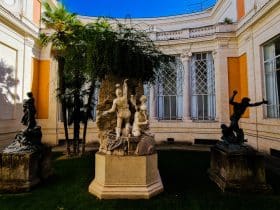
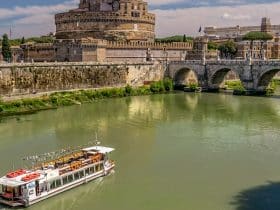
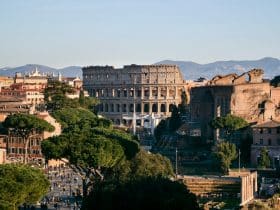

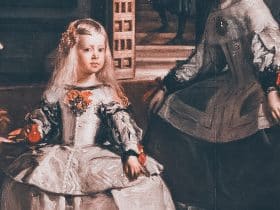
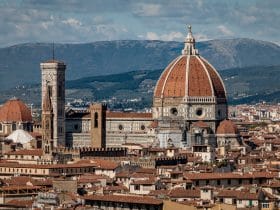
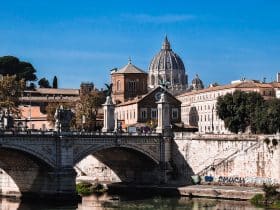
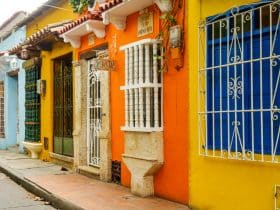

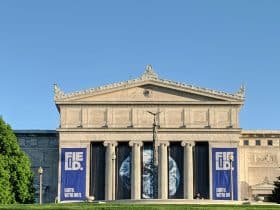











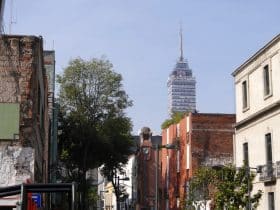
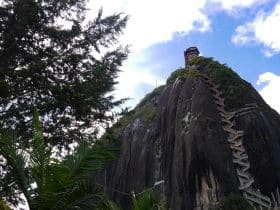

Leave a Reply
View Comments